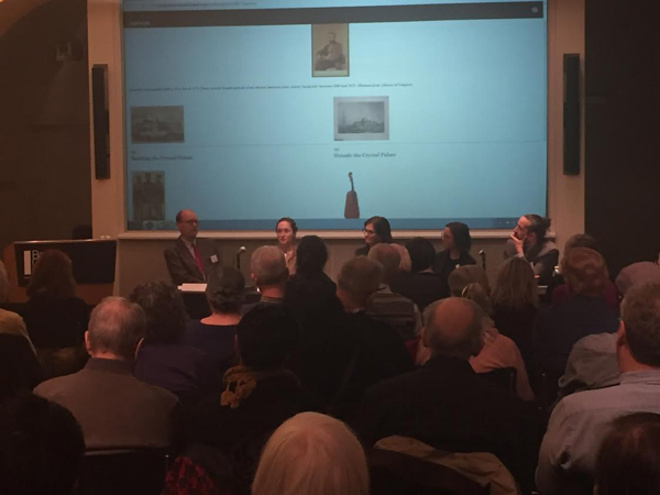
On March 24, the occasion of the opening of the Focus Project exhibition, New York Crystal Palace 1853, Bard Graduate Center hosted a symposium on the first world’s fair held in the United States. The exhibition was initiated by Professor David Jaffee as part of a series exploring the material culture of nineteenth-century New York. Professor Jaffee, who sadly died earlier this year, was still very involved in the project through the fall of 2016. In the 2015–16 academic year, he had taught two classes that were the foundation for the exhibition’s interpretation.
Because Focus Projects are faculty-student curated, the symposium began with a panel comprised of faculty, curators, and alumni who were involved in the process: Professor Ivan Gaskell, head of the Focus Project; Jesse Merandy, director of the Digital Media Lab; Caroline Hannah, associate curator; myself, and another alum, Lara Schilling. Both Lara and I studied with Professor Jaffee and continued to collaborate on the project after graduating. Since much of the research, images, and exhibition objects live online, during the panel presentation, we navigated through digital essays, listened to an extract of the audio tours, and explored the two interactives that are accessible through touch screens in the Gallery. Our contributions to the exhibition and its digital components revealed how New York Crystal Palace 1853 focuses as much on the visitor experience—how people travelled to the fair, other attractions in New York, refreshments at the fair, and on the goods exhibited in 1853–54—as it does on the material and technological innovation, awarded exhibitors, displays, and souvenirs.
Two distinguished scholars gave compelling lectures on aspects of the fair. Amy Ogata, former BGC professor who is now chair of Art History at the University of Southern California, discussed the New York glass and iron building in association with other mid-century Crystal Palaces that had been in London and Paris. Steven Lubar, professor of American Studies at Brown University, shared his research on the New York Crystal Palace official catalogs and guides, as records and promotion of this museum-like fair. He noted that his students have been developing a useful database with 4,000 objects on display at the fair, which can be organized by participating countries or category.
The afternoon closed with ample time for questions and
comments from the audience, moderated by Professor Catherine Whalen. As a collaborative research project and
exhibition, it was interesting to hear different members of the community and
audience answer and ask each other questions about a fair that deserves to be
rediscovered.
~ Ana Estrades (MA, 2016)
